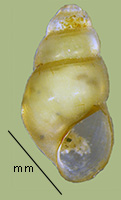> Habitat & Distribution
This is another entry in the rather long list of small, obscure and poorly-known hydrobioid snails of North America. Berry (1943) was the first to discover a living population of Marstonia letsoni, inabiting the "honeycombed cavities" of rocks collected from a temporarily-dewatered pool of the Huron River near Ann Arbor, Michigan. Populations also seem to reach high densities at least sporadically in Lake St. Clair, on bottoms of sand, clay and muck at depths of 1 - 6 meters.
The Illinois Natural History Survey holds a single lot of M. letsoni from the Kishwaukee River, a tributary of the upper Mississippi. The only record from any drainage of the Ohio of which we are aware is a single enigmatic shell discovered by our colleague R. E. Evans on the bank of Elkhorn Creek north of Frankfort.
> Ecology & Life History
The cryptic habitat of Marstonia letsoni seems to suggest a diet that does not ordinarily include algae, but rather very fine organic matter or bacteria. One might speculate that temperature, light, current, and other environmental factors in such a habitat would be fairly constant in the "honeycombed cavities," suggesting constant (perhaps low) levels of reproduction year round. Hydrobiids are typically dioecious, the males being characterized by a penis that arises from the neck. Eggs are generally laid singly, attached in a spare capsule to a solid substrate.
> Taxonomy & Systematics
Bryant Walker (1901) originally described "Amnicola" letsoni from Pleistocene deposits collected on the banks of the Niagara River in upstate New York, transferring the species to Pyrgulopsis in 1918. Berry (1943) published the first biological observations on P. letsoni, including a figure of the penis, which Hershler augmented in 1994. Walker's letsoni was among the 11 eastern species of Pyrgulopsis transferred to the resurrected genus Marstonia by Thompson & Hershler (2002). Marstonia was subsequently retained in the Hydrobiidae (ss) by Wilke and colleagues (2013). Unpublished mtDNA sequence data confirm the similarity of Marstonia letsoni to Marstonia lustrica and other more endemic members of the genus (Pilgrim, pers. comm).
In anatomy, shell morphology and overall biology, Marstonia letsoni seems rather similar to the equally obscure M. scalariformis (Wolf 1869), and (perhaps) to the extinct Marstonia ozarkensis (Hinkley 1915). See my essay of 16Mar20 from the link below. Although similar in shell morphology, however, we tend to think that the scalariformis/letsoni group is distinct from the pachyta group on the basis of penial morphology. See our essays of 4Oct22 and 3Nov22 for comparisons between these two groups of "SNHTHICACBW" Marstonia. More research into this entire enigmatic group would be much welcomed.
> Maps and Supplementary Resources
> Essays
- See my post of January 2016, A new invasive gastropod in the Great Lakes, for several additonal figures of Marstonia letsoni. And read more about the biology of this most poorly-known element of the North American malacofauna in the post that followed, Marstonia letsoni, quite literally obscure.
- I explored the possibility that Marstonia ozarkensis, declared extinct by the USFWS in 2018, might have been a junior synonym of M. letsoni in my 2020 series: What was Marstonia ozarkensis? and Is Marstonia ozarkensis extinct? The latter essay featured a figure of the mysterious Marstonia "letsoni" shell of Kentucky, and broached the possiblity that both letsoni (Walker 1901) and ozarkensis (Hinkley 1915) might prove junior synonyms of Marstonia scalariformis (Wolf 1869).
- Earlier versions of this website, online until August of 2016, adopted the large, broadly-inclusive concept of the Hydrobiidae (sl) following Kabat & Hershler (1993). More recently the FWGNA project has shifted to the Wilke et al. (2013) classification system, distinguishing a much smaller Hydrobiidae (ss) and elevating many hydrobioid taxa previously ranked as subfamilies to the full family level. For more details, see The Classification of the Hydrobioids.
- For background info on the group of Marstonia that Thompson characterized to as “small narrow hydrobiids that have in common a carinate body whorl,” including M. letsoni, see my essay of 4Oct22, The SNHTHICACBW Marstonia 5: scalariformis.
- See my essay of 3Nov22, The SNHTHICACBW Marstonia 6: pachyta, for a comparison between the letsoni/scalariformis subgroup and the pachyta subgroup.
> References
Berry, E. G. (1943) The
Amnicolidae of Michigan: Distribution, ecology, and taxonomy.
Misc. Publ. Mus. Zool. Univ. Mich. 57: 1 - 68.
Hershler, R. (1994) A review of the
North American freshwater snail genus Pyrgulopsis
(Hydrobiidae). Smithsonian Contributions to Zoology 554: 1 -
115.
Thompson,
F. G. & R. Hershler (2002)
Two genera of North American freshwater snails: Marstonia Baker,
1926, resurrected to generic status, and Floridobia,
new genus (Prosobranchia: Hydrobiidae: Nymphophilinae). The
Veliger 45: 269 - 271.
Wilke T., Haase M., Hershler R.,
Liu H-P., Misof
B., Ponder W. (2013)
Pushing short DNA
fragments to the limit: Phylogenetic relationships of “hydrobioid”
gastropods
(Caenogastropoda: Rissooidea). Molec.
Phyl. Evol. 66: 715 – 736.
Walker, B. (1901)
A new Amnicola.
Nautilus 14: 113-114.
Walker, B.
(1918)
A synopsis of the classification of the fresh-water mollusca
of
North America, North of Mexico. University of Michigan Museum
of
Zoology Misc. Publ. 6: 1 - 213.







